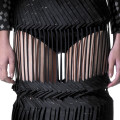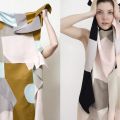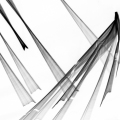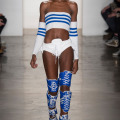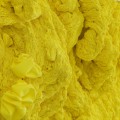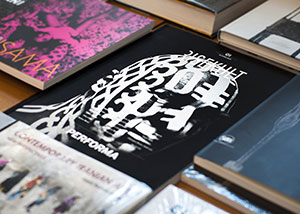Today’s pattern challenge isn’t. By that I mean there’s no challenge for you to figure out because the pattern maker -Shingo Sato- in today’s example shows you how to tender said results. At right is such an example; an origami bodice. Pretty fun huh? You can see the making of this particular example on Youtube. His claim to fame is popularizing the elimination of darting through style lines. His site erroneously claims his “Transformation and Reconstruction” technique is “significantly” different from conventional pattern making since clothes are “constructed in 3D” etc but this is clearly a case of what’s old is new again. It’s nothing new. Anybody who was trained in a good school learned to eliminate darting with style lines. Which is not to say these styles aren’t a departure from the majority of what is on the market today but “his” technique isn’t his and it isn’t new. Heck, I showed how to make a style similar to one of his in the video I made 15 years ago and at lower right is a jacket of mine (circa 1992?) that has no darting in it either but it is very fitted, courtesy of the style lines. I think the value of what he has to offer is the rediscovery of design possibilities for today’s designers. Shingo starts with a muslin bodice on a form. Make careful note that his block is not over fitted(!). I think too many people overfit. From the muslin, he draws in style lines with a sharpie (more on that below) which he then cuts apart to draft the style. Like I’ve said ad nauseum, you can develop styles a lot faster with drafting than draping. I can’t imagine how many hours and hours it’d take to drape the style I opened with but drafting could get you there in an hour or three. If there is a genius to “his” method, it lies in his understanding that this form of instruction is most appropriate with the majority of his seminar students. Drawing style lines on a bodice on a form is much better for designers whose drafting skills have not matured fully. A good pattern maker wouldn’t need this but the way he shows it is a readily transferable way for those whose skills aren’t as solid. I think it is also good for people learning to draft. And then, the styles are very inspirational. The sample above isn’t exactly wearable for most consumers but there are plenty of other styles that can be rendered this way that would be. Considering how bland design has become, I’m hoping Shingo and “his method” will become more popular. He’s posted a bunch of instructional videos, mostly solid information judging from the few I scanned. Keep in mind these were done for demonstration purposes meaning he needs to use a thick sharpie rather than a 4H pencil because the latter can’t be seen by the camera. And he uses lots and lots of pins, placing them at notch points. Again, that is to impart proper matching habits to students but is not something he’d do in real life or at least to this extent. If any of you watch the sewing videos (sewing tight curves, sewing points) I’d be curious to know if this is anything new to you. Other than the too-much pinning, they are accurate. Oh and we build in the marking portions into the pattern with drill holes and such so one wouldn’t need to manually mark everything. Look over some of those and let me know what you think. All in all the drafting processes are great for first patterns but I can only hope you’d hire someone to clean up the styles for production. Or maybe I’m biased. This type of drafting is the sort of work I enjoy most only there’s not much call for it these days. Pity.
Shingo Sato: Transformational Reconstruction
CREDITS: www.fashion-incubator.com
VIDEOCOMMENTSRELATED POST |
|
|
|
|






























